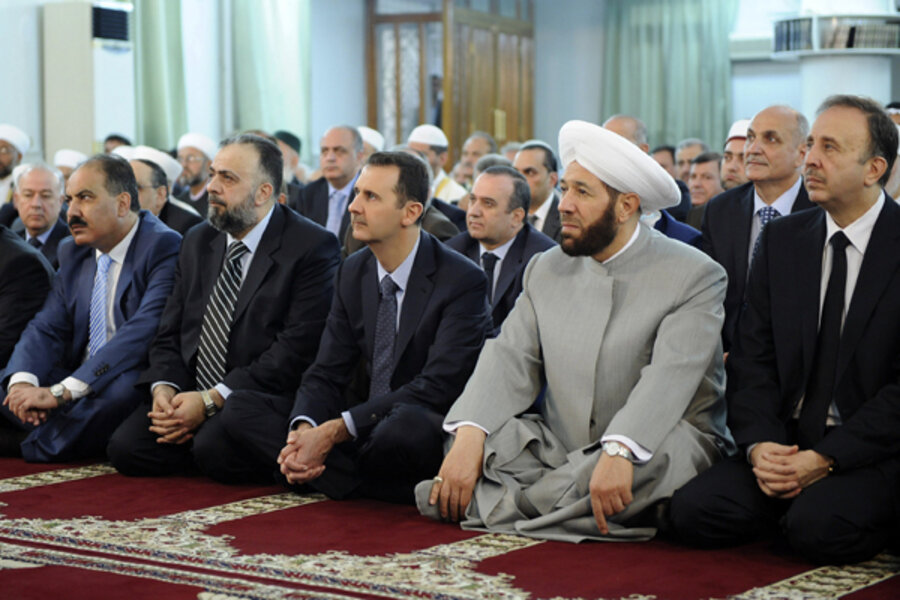Syrian rebels claim direct assault on Assad
Loading...
• A daily summary of global reports on security issues.
Syrian rebels say they targeted President Bashar al-Assad’s convoy with mortar rounds today in the capital of Damascus. If verified, it would be the most direct attack on the Syrian leader since the conflict began in 2011. The government has denied rebel claims.
Artillery shells struck the upscale Malki district this morning, residents confirmed with the Associated Press. But the government showed footage of Mr. Assad praying in the area’s Anas bin Malik Mosque for Eid al-Fitr, the three-day Muslim holiday which marks the end of Ramadan. The information minister said Assad drove his own car to the early morning service and was not a part of a motorcade.
This was Assad’s third public appearance in more than a week. There have been a handful of rebel attacks against Damascus locations he frequents and a deadly bomb wiped out top Assad aides, including his brother-in-law, in Damascus last summer. But according to Reuters, “there have been no reports of Assad himself coming under fire.”
A faction of the Free Syrian Army, Tahrir al-Sham, claimed it fired toward Assad’s convoy after scouting out the route of his motorcade
"The attack rattled the regime, even if Assad was not hit," Firas al-Bitar, the head of the brigade, told Reuters. "There were two motorcades, one containing Assad and a decoy. We targeted the correct one."
There have been no accounts of casualties or damage as a result of the shelling today, notes the AP.
But more than two years into the Syrian conflict, many question whether the death of Assad would hasten the end of the largely sectarian battle.
“The two words that really describe Syria today are stalemate and deadlock,” Fawaz Gerges, director of the Middle East Centre at the London School of Economics, told The Christian Science Monitor late last month. “This is the worst scenario because what political deadlock and military stalemate mean is that it’s turning into a war of attrition, it’s a long war, it’s a costly war. Neither side has the means to deliver a decisive blow. What this means is more casualties, more escalation, and more suffering for the Syrian population.”
According to the Monitor, the crisis in Syria, “is one of the worst humanitarian disasters in decades.”
The United Nations estimates that the conflict claims as many as 5,000 lives per month, nearly 1 in 3 Syrians are refugees or displaced inside the country, and there are 6.8 million Syrians in need of urgent assistance. Even the most devout newsreader can get lost in the flurry of statistics and layers of conflict.
Rebel groups are splintering and growing, as foreign fighters with their own agendas capitalize on the conflict. A separate Monitor report notes that “there are now at least 1,200 different armed opposition groups” in Syria, “making it difficult to determine who is a legitimate fighting group and who is a criminal gang.”
The north of the country is largely rebel-held, with foreign fighters capturing a key airbase near the city of Aleppo earlier this week, reports The Wall Street Journal. But Assad’s troops have made advances near the Lebanese border and in Homs, and has a strong hold on the center of the country, according to the AP.
“If you see gains being made by the opposition, you’ll find that they’re not being made in those areas. They’re being made in other areas … where the regime is not pouring resources in there to hold them at all costs," Amr Al Azm, an associate professor of Middle East history and anthropology at Shawnee State University in Ohio told the Monitor last month. "Whereas around Homs they’ll put resources to fight at all costs and the same in Damascus."








